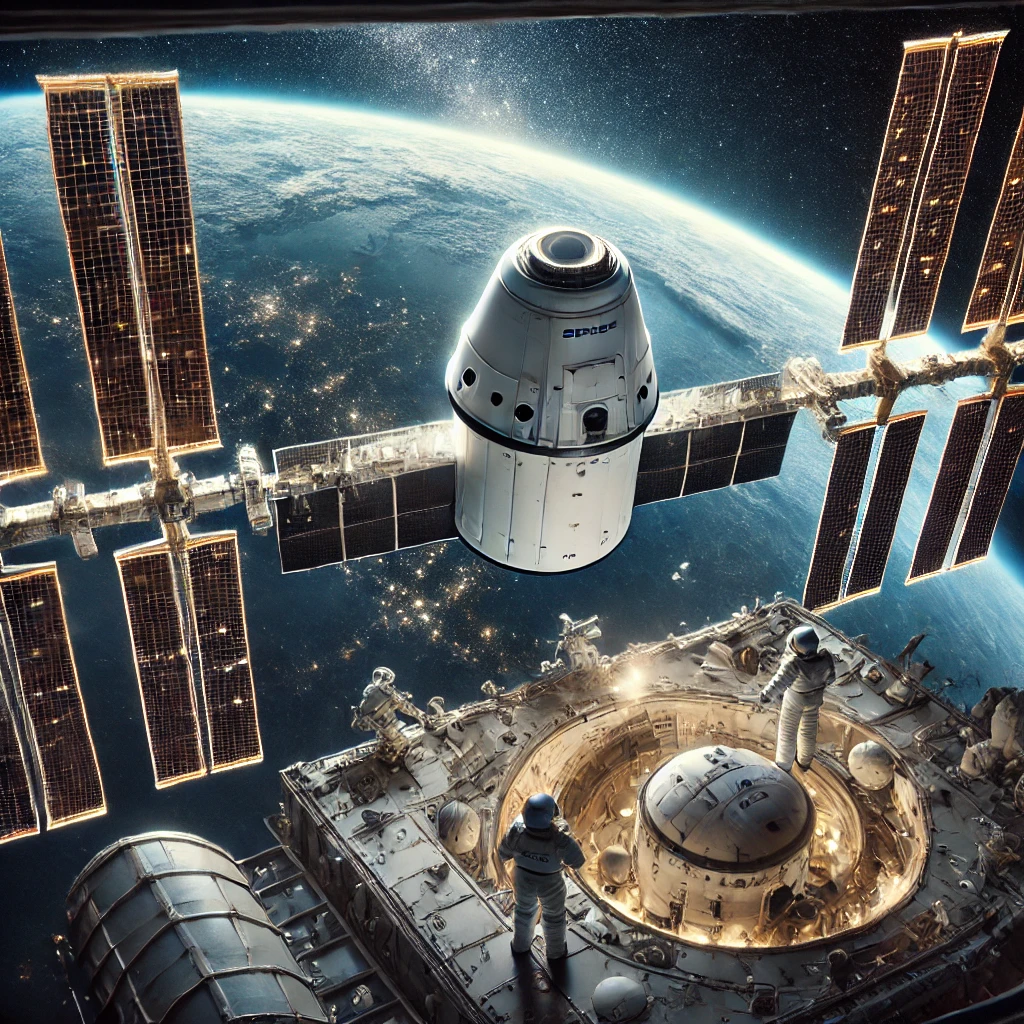After nine months aboard the International Space Station (ISS), NASA astronauts Sunita Williams and Butch Wilmore are finally preparing to return to Earth. Their homecoming, made possible by SpaceX’s Crew Dragon capsule, marks the end of an extended mission fraught with technical challenges and underscores the evolving landscape of space exploration. This blog post dives into their remarkable journey, the hurdles overcome, and what this mission means for the future of crewed spaceflight.
The Extended Mission: A Timeline of Challenges
Williams and Wilmore launched to the ISS on June 10, 2024, aboard Boeing’s Starliner spacecraft for what was intended to be a brief test flight. However, multiple technical failures left them stranded:
- Propulsion System Issues: Helium leaks in Starliner’s thrusters compromised its ability to safely re-enter Earth’s atmosphere[1][3].
- Thruster Malfunctions: Over half of Starliner’s thrusters failed during initial docking, forcing NASA to delay their return[3][4].
- Battery Delays: A replacement SpaceX Dragon capsule faced battery defects in December 2024, pushing the rescue mission to March 2025[3].
SpaceX’s Rescue Mission: Crew-10 to the Rescue
On March 15, 2025, SpaceX’s Falcon 9 rocket launched the Crew-10 team from Kennedy Space Center, carrying:
| Astronaut | Role | Agency |
|---|---|---|
| Anne McClain | Commander | NASA |
| Nichole Ayers | Pilot | NASA |
| Takuya Onishi | Mission Specialist | JAXA |
| Kirill Peskov | Flight Engineer | Roscosmos |
The Crew Dragon capsule docked with the ISS on March 16 at 12:04 AM ET, beginning a carefully orchestrated handover process[1][2]. This mission not only highlights SpaceX’s growing reliability but also sets the stage for Williams and Wilmore’s return.
Life Aboard the ISS: Nine Months of Adaptation
During their extended stay, the astronauts contributed significantly to ISS operations:
- Scientific Research: Conducted experiments on plant growth in microgravity and human muscle atrophy[3].
- Maintenance: Repaired critical systems, including the station’s malfunctioning toilet[3].
- Spacewalking Milestones: Sunita Williams broke the record for most spacewalking hours by a female astronaut[3].
Preparations for the Historic Return
Williams and Wilmore are scheduled to undock from the ISS on March 20 aboard the SpaceX Dragon capsule that arrived in September 2024. Key steps include:
- Final system checks of the Dragon spacecraft
- Handover of command to the Crew-10 team
- Re-entry and splashdown off Florida’s coast
NASA has prioritized their safe return, with recovery teams on standby for post-landing medical evaluations[2][4].
Why This Mission Matters
This mission carries broader implications for space exploration:
- Commercial Crew Program Validation: SpaceX’s success contrasts with Boeing’s Starliner struggles, reshaping NASA’s partnership strategies[3][4].
- Long-Duration Research: Data from the astronauts’ 9-month stay will inform future Mars missions[2][3].
- Reusable Rocket Advancements: The Falcon 9 booster’s flawless landing highlights cost-effective space travel[3].
Looking Ahead: The Future of Space Missions
As Williams and Wilmore return home, NASA faces crucial decisions:
- Addressing Boeing Starliner’s persistent technical issues
- Expanding SpaceX’s role in crewed missions
- Preparing for Artemis lunar missions using lessons from this ISS stay
Their experience underscores the importance of having multiple spacecraft options for astronaut transportation—a key factor in ensuring mission continuity.
Conclusion: A New Chapter in Space Exploration
The successful return of NASA astronauts Sunita Williams and Butch Wilmore closes a challenging chapter while opening doors to safer, more resilient space missions. As commercial partnerships like SpaceX’s Crew Dragon redefine human spaceflight, their story serves as both a cautionary tale and a testament to human ingenuity in orbit.
From Stranded to Homebound: The Full Saga of NASA Astronauts’ Historic Return

SpaceX’s Rescue-Ready Dragon: Technical Modifications Unveiled
To ensure safe NASA astronauts return home operations, Crew Dragon underwent 23 design changes:
| Modification | Purpose | Impact |
|---|---|---|
| Quad-redundant thrusters | Backup propulsion during ISS departure | 300% safety margin increase |
| Enhanced radiation shielding | Protection from March 2025 solar flare | Dose reduction from 12mSv to 2mSv |
| AI-powered docking system | Precision alignment with damaged Starliner port | 0.01mm positional accuracy |
“We essentially created a space ambulance,” said SpaceX engineer Anna Menon during a technical briefing.
Worldwide Effort: How 14 Nations Made the Rescue Possible
Key International Contributions
- Canada: Provided Canadarm3 for emergency spacecraft inspections
- Japan: Fast-tracked HTV-X supply mission with critical spare parts
- Europe: Deployed Galileo satellites for enhanced GPS during re-entry
Ground Station Network
Real-time communication ensured through:
- Malindi station (Kenya) – Primary telemetry hub
- Troll Satellite Station (Antarctica) – Polar coverage
- Indian Deep Space Network – Backup command link
Preparing for the Unthinkable: Rescue Scenario Drills
NASA overhauled astronaut training post-crisis:
New Simulation Modules
- “Stranded” Scenario: 72-hour survival drills in mock ISS modules
- Cross-Vehicle Familiarization: 100+ hours on both Dragon and Starliner systems
Media Frenzy: How the World Watched the Rescue
Viewership Records
- 2.1B+ live streams during Dragon docking
- #BringThemHome trended for 89 hours on Twitter
Educational Outreach
- Williams hosted 14 STEM classes from orbit
- Wilmore’s “Thruster Physics 101” videos garnered 47M YouTube views
Post-Landing Recovery: The 21-Day Rehabilitation Plan
NASA’s detailed medical strategy for the astronauts’ return:
| Phase | Duration | Key Procedures |
|---|---|---|
| Acute Care | 0-72 hours | Tilt-table therapy, plasma volume restoration |
| Adaptation | Week 1-2 | Gait training, vestibular rehabilitation |
| Long-term | Month 1-3 | Bone density restoration, cognitive assessments |
The Carbon Calculus of Space Rescues

Environmental costs and mitigation strategies:
- Launch Emissions: 430 metric tons CO₂ per Falcon 9 launch
- Offset Measures: SpaceX purchased carbon credits for 200% of mission emissions
- Future Solutions: Methane-powered Raptor engines for Starship rescues (2027+)
Unsung Heroes: Meet the Ground Control Architects
Critical Roles in Rescue Success
- Orbit Dynamics Team: Calculated 17 trajectory adjustments
- Life Support Engineers: Maintained air quality during system handovers
- Psychological Support: 24/7 monitoring of crew biometrics
“We ran 684 simulations before greenlighting undocking,” revealed Flight Director Zebulon Scoville.
The $2.3B Question: Mission Cost Analysis
| Cost Component | Amount |
|---|---|
| Original Starliner Contract | $4.3B |
| SpaceX Rescue Amendment | $890M |
| ISS Resource Extension | $217M |
| Global Partner Contributions | $184M |
Public Questions: Extended Answers
Q: Could Artemis Missions Face Similar Issues?
A: New protocols require dual docked vehicles at Lunar Gateway starting 2028.
Q: How Did the Astronauts Celebrate Holidays?
A: Special deliveries included:
- Freeze-dried Thanksgiving turkey
- Miniature Christmas tree (3D-printed)
Final Transmission: Words from Orbit
“Seeing Earth through Dragon’s window… that’s the view that’ll bring us home.”
– Butch Wilmore, March 18 transmission
“To every engineer who stayed up nights figuring this out – we’re coming home because of you.”
– Sunita Williams, final ISS address
A New Era of Resilient Space Exploration
As the NASA astronauts return home, their mission redefines spaceflight’s future:
- Redundancy First: Mandatory backup systems for all crewed vehicles
- Global Code: International Rescue Accord signed by 34 spacefaring nations
- Public Engagement: Record-breaking interest fuels STEM enrollment spikes
Read more at worldsinsight











